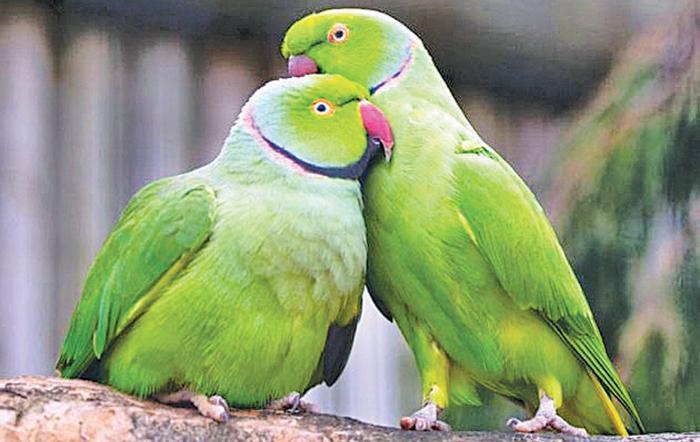
Why talk of parrots when there are so many other birds that demand man’s attention? But parrots are unique in many ways. No other bird had been enshrined among royalty at Westminster Abbey except a parrot. It was an African grey that succumbed to grief only a few days after its mistress, the Duchess of Richmond and Lennox died in 1702. Even today, you can see the parrot perched next to her wax effigy. It is supposed to be the oldest stuffed parrot in England.
Parrot is the common name applied to members of the large bird family “Psittacidae” who have common names such as, cockatoos, lories, love birds, macaws and parakeets. Parrots have curved, hooked bills and short legs. Their first and fourth toes are turned backward. As a result, they walk awkwardly, but they are capable of climbing trees. They use their bills to pull themselves up to higher branches of a tree. In most parrots the tongue is thick and muscular. Most parrots are tropical. They are found in South America, Australia, New Guinea, Africa and Asia. Parrots live in tree holes, termite mounds, rock cavities and ground tunnels.
The parrot is one of the few birds that had a lasting bond with man. Centuries ago, the Roman poet Ovid wrote an elegy on the death of a parrot belonging to one of his female friends. The parrot is capable of entertaining its owner with its coos, tweets, squeaks and ululations. People love to have parrots as pets because they learn the human lingo quite easily. If you speak in English, it will pick up English words and phrases. If you speak any other language, the parrot will do the same.
Peculiar
Mark Twain considered people who kept parrots were peculiar. He had a female admirer who was not quite refined. However, Twain liked her simply because she kept a parrot. Even Alexander the Great loved parrots.
The celebrated Greek philosopher Aristotle who tutored Alexander had a soft corner for parrots. Ancient Romans loved parrots and put them in ornate cages made out of tortoise shell and ivory.
Even today, parrots have a big demand because they can imitate the human voice and other intrinsic sounds. The heavy demand of the cage-bird trade together with the loss of habitat has resulted in many species of parrots becoming endangered.
Apart from imitating the human voice, the parrot is capable of whistling, chirping and squawking. Unlike other birds, it can mimic radio jabber, sound of car engines, burbles of rain, coughing, or any other silly things you might do. It has different postures.
It can bob, pace, huddle, climb, walk upside down, swivel its head, strut and hold its ford daintily. Quite unusually, it can sleep while sitting on its perch. The parrot knows how to balance its body with its hind toes. If you provoke it, the parrot can get into a fighting mood. Then it rears its back with wide spread wings and spits defiance.
Have you ever observed how it flies? The parrot flaps its wings with some effort. However much you feed or look after your pet parrot, it will not look at you in servitude. If the parrot really likes you, it will bow its head in grace.
Even if you do not teach it any words or phrases, the parrot will pick them up. This is because the parrot can concentrate and pay attention to what is happening around it. Usually, the parrot is an enigmatic bird. You cannot understand or gauge it.
The parrot’s face will remind you of the Mona Lisa. You will never know what they are thinking. Both, Mona Lisa and the parrot seem to be suppressing a giggle. You might agree, the parrot’s eyes are like those of an insane man. It is sometimes vain and at other times soft and lovable.
Faithful
With all its changing moods, the parrot would remain faithful to its owner. It will ignore unknown people trying to teach words and tricks. Its favourite foods include fruits, nuts and sun flower seeds. Like a beauty queen the parrot tries to maintain its figure. You can see the parrot preening its glossy plumage while standing on its short legs and turning its bill which is as sharp as a Swiss army knife.
There are more than 300 species of parrots in South America, Africa, Asia and Australia. The red-cheeked Australian parrot lays three to five eggs in hollow trees. Their mating season is from August to January. The hooded and multi-coloured parrot lays four to seven eggs at a time in their nests in hollow branches. Their mating season is from July to January. The blue-winged parrot lays four to six eggs at a time in stumps or hollow logs. Their breeding season is from August to January.
In the past children learnt words and phrases parrot fashion by repeating them many times. Unfortunately, they did not understand what the words and phrases meant. As children we had to memorise stanzas in “Buddhagajjaya” and “Sakaskada” by repeating them aloud. We were not mature enough to understand their meanings. However, our difficult exercise had one salutary effect. It worked like voice training.
Parrots, like humans, value their freedom. Even if you keep a parrot in a golden cage and feed it with the choicest foods, it will not be happy. Therefore, spare a thought for such innocent birds that embellish the natural surroundings of Mother Earth.
